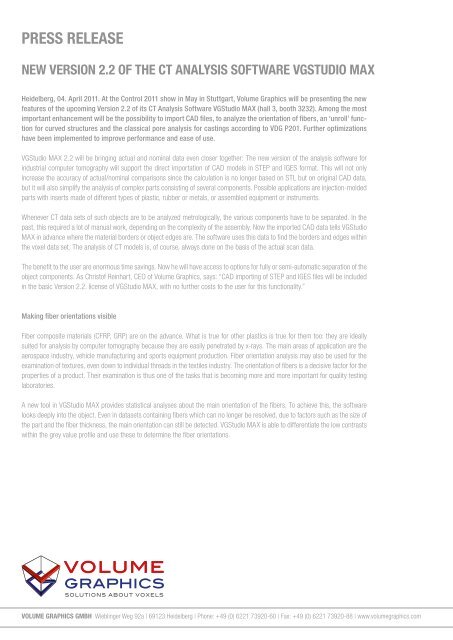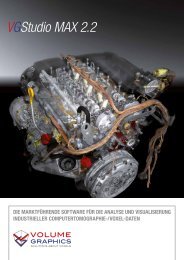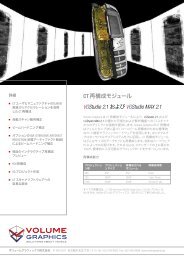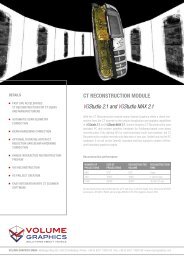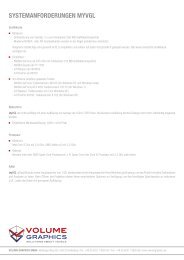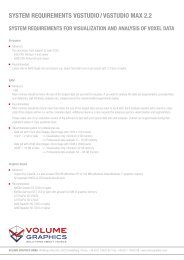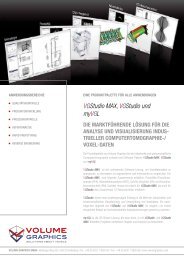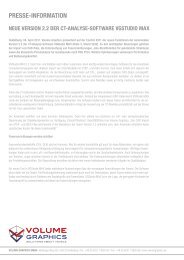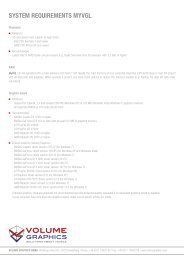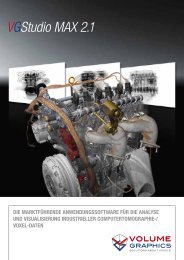PRESS RELEASE - Volume Graphics
PRESS RELEASE - Volume Graphics
PRESS RELEASE - Volume Graphics
You also want an ePaper? Increase the reach of your titles
YUMPU automatically turns print PDFs into web optimized ePapers that Google loves.
<strong>PRESS</strong> <strong>RELEASE</strong><br />
NEw VERSioN 2.2 of thE Ct ANALySiS SoftwARE VGStudio MAX<br />
Heidelberg, 04. April 2011. At the Control 2011 show in May in Stuttgart, <strong>Volume</strong> <strong>Graphics</strong> will be presenting the new<br />
features of the upcoming Version 2.2 of its CT Analysis Software VGStudio MAX (hall 3, booth 3232). Among the most<br />
important enhancement will be the possibility to import CAD files, to analyze the orientation of fibers, an ‘unroll’ function<br />
for curved structures and the classical pore analysis for castings according to VDG P201. Further optimizations<br />
have been implemented to improve performance and ease of use.<br />
VGStudio MAX 2.2 will be bringing actual and nominal data even closer together: The new version of the analysis software for<br />
industrial computer tomography will support the direct importation of CAD models in STEP and IGES format. This will not only<br />
increase the accuracy of actual/nominal comparisons since the calculation is no longer based on STL but on original CAD data,<br />
but it will also simplify the analysis of complex parts consisting of several components. Possible applications are injection-molded<br />
parts with inserts made of different types of plastic, rubber or metals, or assembled equipment or instruments.<br />
Whenever CT data sets of such objects are to be analyzed metrologically, the various components have to be separated. In the<br />
past, this required a lot of manual work, depending on the complexity of the assembly. Now the imported CAD data tells VGStudio<br />
MAX in advance where the material borders or object edges are. The software uses this data to find the borders and edges within<br />
the voxel data set. The analysis of CT models is, of course, always done on the basis of the actual scan data.<br />
The benefit to the user are enormous time savings. Now he will have access to options for fully or semi-automatic separation of the<br />
object components. As Christof Reinhart, CEO of <strong>Volume</strong> <strong>Graphics</strong>, says: “CAD importing of STEP and IGES files will be included<br />
in the basic Version 2.2. license of VGStudio MAX, with no further costs to the user for this functionality.”<br />
Making fiber orientations visible<br />
Fiber composite materials (CFRP, GRP) are on the advance. What is true for other plastics is true for them too: they are ideally<br />
suited for analysis by computer tomography because they are easily penetrated by x-rays. The main areas of application are the<br />
aerospace industry, vehicle manufacturing and sports equipment production. Fiber orientation analysis may also be used for the<br />
examination of textures, even down to individual threads in the textiles industry. The orientation of fibers is a decisive factor for the<br />
properties of a product. Their examination is thus one of the tasks that is becoming more and more important for quality testing<br />
laboratories.<br />
A new tool in VGStudio MAX provides statistical analyses about the main orientation of the fibers. To achieve this, the software<br />
looks deeply into the object. Even in datasets containing fibers which can no longer be resolved, due to factors such as the size of<br />
the part and the fiber thickness, the main orientation can still be detected. VGStudio MAX is able to differentiate the low contrasts<br />
within the grey value profile and use these to determine the fiber orientations.<br />
VoLuME GRAPhiCS GMbh Wieblinger Weg 92a | 69123 Heidelberg | Phone: +49 (0) 6221 73920-60 | Fax: +49 (0) 6221 73920-88 | www.volumegraphics.com
The fiber orientation analysis available with VGStudio MAX 2.2 is a response to the increasing use of fiber composite materials.<br />
‘Unrolling’ of curved objects<br />
When analyzing objects which are curved in the widest sense of the word, customers often wish to ‘unroll’ the part into a plane<br />
along a line. Background: This enables the user to display 2D slice images at right angle to the unrolling direction and then scroll<br />
through the object. In this way you can, for example, examine the contact of thread flanks. Another example is the examination<br />
of tire profiles (see figure).<br />
This method also works for deformed or distorted parts where it is important to straighten rather than unroll them. A possible<br />
application may be printed circuit boards in the electronics industry. A planar representation of the circuit paths is required for<br />
examination. The software allows the deformations to be ‘corrected’ on screen to achieve a plane. The unrolled or straightened<br />
part can then be conveniently displayed in a separate window of the workspace.<br />
VGStudio MAX 2.2 allows sections curved in the widest sense of the word to be ‘unrolled’ into a plane. The image shows a violet circumferential section<br />
of a tire profile and the unrolled image.<br />
VoLuME GRAPhiCS GMbh Wieblinger Weg 92a | 69123 Heidelberg | Phone: +49 (0) 6221 73920-60 | Fax: +49 (0) 6221 73920-88 | www.volumegraphics.com
Classical pore analysis according to VDG P201<br />
Following numerous requests from our customers, VGStudio MAX 2.2 will support examinations according to VDG Specification<br />
P201. <strong>Volume</strong> <strong>Graphics</strong> has transposed the classical procedure, based on real sections of parts and microscopic examination as<br />
described in this specification, into its software. Part of the process is, for example, the fitting of reference planes into the section<br />
of a part or the classification of different defects. “We are using a complicated 2D algorithm which is able to handle sub-voxels for<br />
the analysis and thus achieves very precise results”, states Christof Reinhart. “We are getting very close to the classical methods<br />
with this: voxel-based and microscopic analyses are getting more comparable.”<br />
A new tool in VGStudio MAX 2.2 provides porosity analyses according to VDG P201.<br />
Higher performance and easier use<br />
Last but not least a number of improvements of smaller details will be providing some extra performance and improved handling,<br />
for example within the Coordinate Measurement add-on module.<br />
One fundamental enhancement is the introduction of a more efficient data structure, reducing the memory consumption of the<br />
software. This is an advantage for users with lower performance PCs who want to display the datasets using our viewer but who<br />
do not want to perform their own analyses. This group often uses only standard PCs which quickly reach their limit when having<br />
to handle large amounts of data.<br />
High-end software made in Germany<br />
<strong>Volume</strong> <strong>Graphics</strong> develops software for the processing of voxel data (voxel = three-dimensional pixel). The company was founded<br />
14 years ago and today has 34 employees. The development projects of the early years have led to the development of the software<br />
product VGStudio MAX, the leading analysis software in the area of computed tomography. The application kernel used can<br />
handle data from the worlds of CT and CAD. Further information: www.volumegraphics.com<br />
VoLuME GRAPhiCS GMbh Wieblinger Weg 92a | 69123 Heidelberg | Phone: +49 (0) 6221 73920-60 | Fax: +49 (0) 6221 73920-88 | www.volumegraphics.com


